I know choosing an efficient powder-packing machine can be an overwhelming task without the right information.
A reason this guide explores fundamental aspects of powder packing machines such as filling techniques, classification, benefits, practical applications, features, and parts to working principle.
So, if you want to be an expert in powder-filling machines, read this guide.
1. Filling Techniques In Powder Packing Machines
You can apply many filling techniques in powder packing machines.
Some of these techniques include:
Auger Fillers
The powder mix is held in a hopper that looks like a cone. The fillers use it to fill the pouches by use of an auger conveyor.
The powder is then filled into a pouch or container. Afterward, it is capped or sealed using heaters.
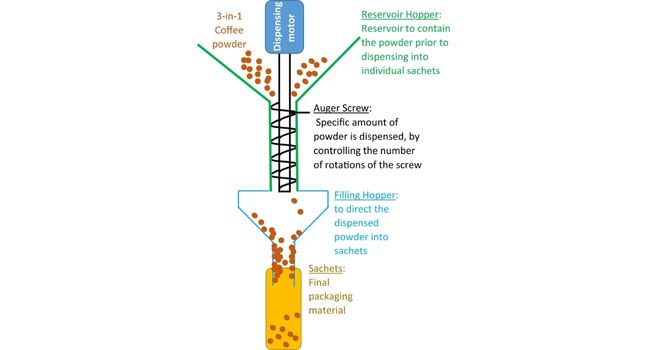
Auger filler mechanism
Vibratory Weigh Fillers
This type of filling technique is suitable for linear feeders. It is very versatile, has a high operation speed, and is accurate.
They measure the powder product in precise weights and fill them into pouches or containers.
2. Types Of Powder Packing Machines
Some of the most common types of powder packing machines include:
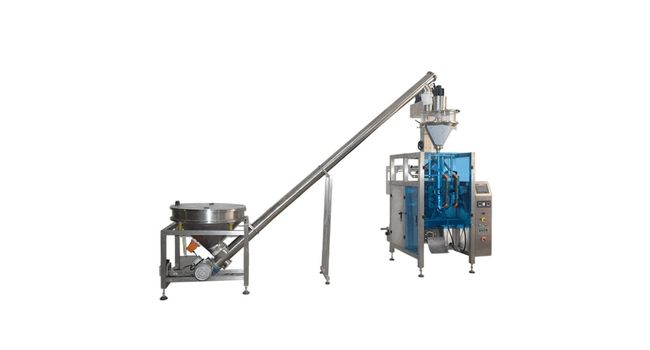
Powder packing machine
i. Vertical Powder Packing Machine
This machine uses the vertical form-fill-seal method to pack various powder products such as coffee powder, seasoning powder, and milk powder.
You can use film packaging. The machine will fill powder and fill with high accuracy.
The powder packaging speed is fast and reliable.
ii. Rotary Powder Packing Machine
The Rotary Powder Packing Machine employs the rotary form-fill-seal method, which uses preformed packages to seal the products.
You will use bag-gripping arms to feed the premade packages.
iii. Automatic Can Packing Machine
These automatic machines can fill, seal, cap, and label a wide range of containers like bottles, cans, and jars.
iv. Stick Pack Powder Packing Machine
These machines use multiple lanes to pack powder products. They pack these materials in sticks or sachets.
You can use it to pack single-serve products. Consumers like these packaging due to their portability and convenience.
v. Inline Powder Packing Machine
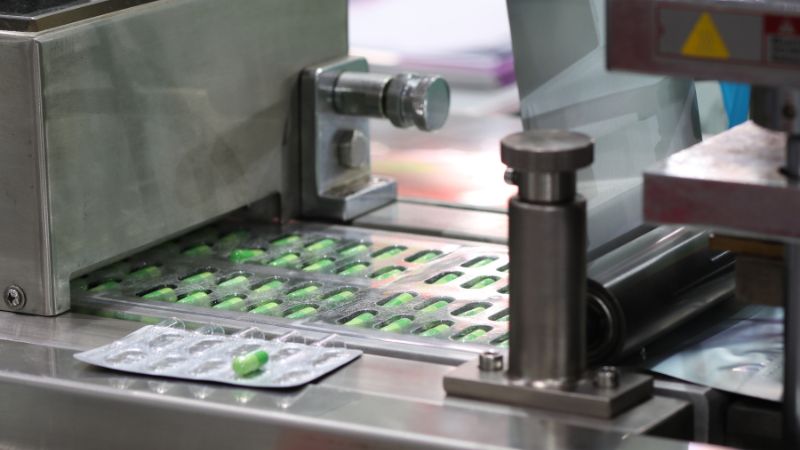
Inline powder packing machines pack the powder in a straight, orderly line.
You can start the process and end on one line with a single infeed and outfeed lane.
Although they require a large floor space, inspecting each packing station is easy.
3. Importance Of Bulk Density In Powder Packing Machine
The bulk density of powder products determines the compactness of powder products under pressure.
Granulated sugar is part of the dry powder products with low bulk density.
On the other hand, brown sugar is an example of a non-free-flow powder. It has a higher bulk density than granulated sugar.
Of course, this is due to the cohesive nature of brown sugar.
Interestingly, the bulk density of brown sugar increases with compaction.
When a Powder Packing Machine packages two products of free-flow and non-free-flow powder, the package dimensions will vary.
It is due to the space inside and around the product.
The free-flow powder does not compress easily. It has a lot of empty space hence a large pouch.
That is the importance of Bulk Density in Powder Packing Machines since it directly influences the package attributes and pouch size.
Bulk Density also determines the type of filler needed and the level of packaging speed your machine can attain.
4. Semi-Automatic Powder Packing Machine Vs. Fully Automatic Powder Packing Machine
In Semi-Automatic Powder Packing Machines, the design requires the container or pouch to be physically put by an operator into the machine.
Some of the procedures in the Semi-Automatic Powder Packing Machines are automated. However, some operations are manual.
The fully automatic powder packing machine requires no or minimal human intervention.
You will input the required parameters of operation. Then the machine will operate autonomously.
Such powder packaging machines use sensors to coordinate and control various operations during the packaging process.
These sensors enable the packaging machine to operate continuously.
As a result, it eradicates human error compared to Semi-Automatic Powder Packing Machines.
5. Free-Flow Powder Vs. Non-Free-Flower Powder In Powder Packing Machines
A Powder product is free-flowing when the particles are not cohesive, like in granulated table salt or sugar.
It means that when dispensed, they will freely flow. No amount of additional pressure can compact them or their shape manipulated.
A powder product is non-free-flowing when its particles are cohesive, like powdered milk or brown sugar.
You can easily manipulate the powder to form any shape you desire. Additionally, you can apply pressure to compact the powders.
The “Finger Test” is an unconventional way of determining whether a product is free-flow or non-free-flow.
You will poke a finger into the container with the powder product.
For a non-free-flow powder, the indention will remain even after removing the finger. Of course, this happens after the initial compression.
On the other hand, for free-flow powder, the indention will not last after removing the finger.
This greatly assists in determining what kind of filler the packing requires for efficient dispensation of the powder product.
For free-flow powder products, you can choose an auger powder filler or volumetric powder filler.
On the other hand, non-free-flow powder products will require a specialized auger filler that can effectively dispense the cohesive product.
6. Applications Of Powder Packing Machine
You can use powder packing machines for many materials in different industries.
You can use these machines in any of the following areas:
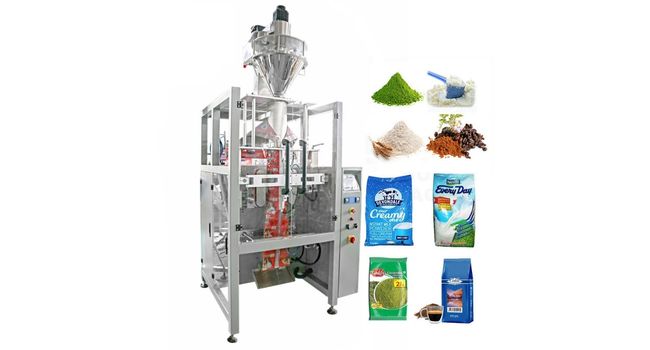
Dry powder packaging machine
Pharmaceutical Industry
The major products in this industry packed using this machine are mainly powdered drugs.
Chemical Industry
The most common products in this industry packed using the Powder Packing Machine Include non-liquid powder materials and powder coatings.
Some products you can package include pesticides, veterinary powder, laundry detergents, etc.
Food Industry
In the food industry, you can package powdered milk, coffee, tea, salt, spices, flour, and sugar, to mention a few.
Cosmetics Industry
Cosmetic detergents and baby powders are the most common products you can package.
7. Limitations Of A Powder Packing Machine
Even as you plan to purchase a powder packing machine, consider some of these limitations:
High Initial Cost
The initial cost of the powder filling and sealing machine is high.
Fully automatic machines are the most expensive. They are best for high-capacity packaging.
Of course, the manual powder packaging machine is affordable. However, this machine is suitable for low production capacity.
Specificity
Most machines in the market feature unique designs for specific powder packaging applications.
Therefore, such machines can only handle specific powders. Ideally, this will limit diversification during the production process.
Particular To Powder
Most of these machines can only handle powder products with specific flow levels.
8. Stick Powder Packing Vs. Sachet Powder Packing
Both Stick and Sachet Powder Packing Machines are similar. That is, in both parts and principles of operation.
The difference is mainly the packaging design.
One machine uses a sachet, while the other uses a stick for packaging powder.
The sachet packing machine can package sachets in different sachet styles. These include the 4-side seal, 3-side seal, and foreign sachet.
A Stick Powder Packing Machine packages products on a 2-side seal only but in a similar process as the Sachet Packing Machine.
You can learn more about:
9. Powder Packing Machine Vs. Liquid Filling Machines
A Liquid Filling Machine requires high pressure for packaging.
This explains the name liquid pressure filling machine.
Therefore, the liquid pressure will determine the products’ flow rate.
You can adjust the filling mechanism to fill different sizes of bottles.
A “No Bottle No Fill” feature enables the machine to stop automatically. In the event, there is no bottle to fill in the conveyor system.
Powder Packing Machine, on the other hand, handles only powder products and packages them in pouches or containers.
The powder is dispensed into the containers or packages using an auger filler and then sealed or tightly capped.
10. Features Of A Powder Packing Machine
Some of the prominent features of a Powder Packing Machine include:
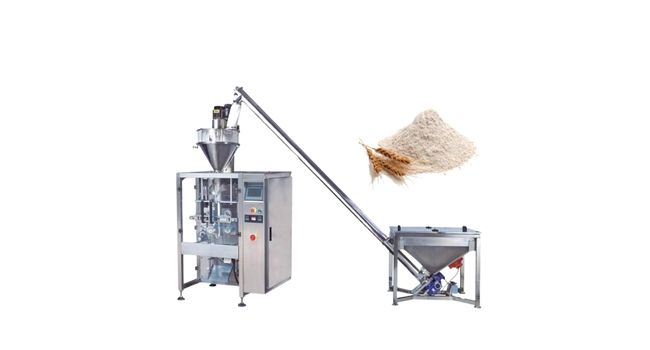
Powder filling and sealing machine
- They generally work at very high speeds, mostly around 108 strokes per minute, with high performance and efficiency
- There are either automatic or semi-automatic machines. The automatic machines have a PLC control system with HMI and monitoring mechanism.
- Auger filling system featuring servo control is a reliable technique
- The machine structure and any part in contact with the powder product is stainless steel. Stainless steel is durable and environmentally friendly.
- As long as you set the parameters right, these machines can fill different powders.
11. Benefits Of A Powder Packing Machine
Some of the main benefits of investing in powder filling and sealing machines include the following:
Upgraded Brand Value
Flexible packaging options allow for easy brand awareness.
Therefore, you can design your unique powder packaging for better marketing strategies.
Cost And Time Effective
Although the initial cost of powder packaging machines is high, they are cost-effective in the long run.
Improved Functionality And Reliability
Modern powder packing machines have unlimited functionalities. They can handle a range of packaging actions, including capping, sealing, printing to quality inspection.
Improved Product Shelf Life
Powder packaging equipment greatly ensures the safety of products. With zero contamination during packaging, it guarantees improved shelf life of products.
12. Trouble Shooting A Powder Packing Machine
Most breakdowns in machines are due to human error or mechanical problems.
Some of the common problems and their solutions in a Powder Packing Machine include:
Hot-Tack Problems
It is a situation the packing material cannot sustain the weight of the powder during sealing and heating.
To counter this, you can make the seal stronger.
You can achieve this by increasing the temperature of the sealing area.
Blasts of cold air can increase the strength of the hot track.
Stretched Bag Length
You can rectify this by adjusting the bag length parameter to the correct length.
Alternatively, you can re-set the bag length.
You should check the registration photo-eye. It will confirm whether you have set it correctly or not.
Defective Seal Reliability
There are situations where the seals may not be as tight as you want. You should align the sealing jaws.
Always make the jaws parallel while maintaining a steady temperature.
Additionally, you should test the gusset pressure. It is for machines handling gusset bags.
Varying Bag Size
You should clean the film belts.
Additionally, adjust the tension in the film feeding belt.
Again, you should thread the film for a continuous flow and avoid offset.
13. Considerations For Powder Packing Of Dusty Powder Products
Some non-free-flow powder products like flour tend to form clouds of dust.
It is common when you dispense such powders from filling and sealing machines.
These loose particulates, which are airborne, can result in very serious mechanical damage.
To prevent this, some Powder Packing Machinery Options need to be considered when the product has a lot of dust:
- The Powder Packing Machine should have an IP rating that is dust-tight or dust-protected.
It will prevent the dust from getting into the machine enclosure. - The Packing Machine should have an enclosed jaw drive. They will protect vital moving parts that are running the sealing jaws.
- Packing using continuous motion at high speed ensures that a constant airflow downwards is maintained.
This assists in stray dust particulates into the pouch.
14. Powder Packing Machine Vs. Granule Packing Machine
Powder Packing Machines are more or less similar to Granule Packing Machines in structure and operating principles.
The Powder Packing Machine handles both free-flowing and non-free-flowing powdered products.
The free-flowing powder product is mostly granulated, like brown sugar, with other non-free-flowing products being granular too.
The only difference with the product packed by Granule Packing Machine is the size of the granule product.
The Granule Packing Machine handles larger granules compared to the Powder Packing Machine. Their operating principle remains the same, with slight variations depending on the machine design and the packed product.
15. Components Of A Powder Packing Machine
Powder Packing Machines contains various components important in the powder-filling process.
The location of each component varies from one machine to another.
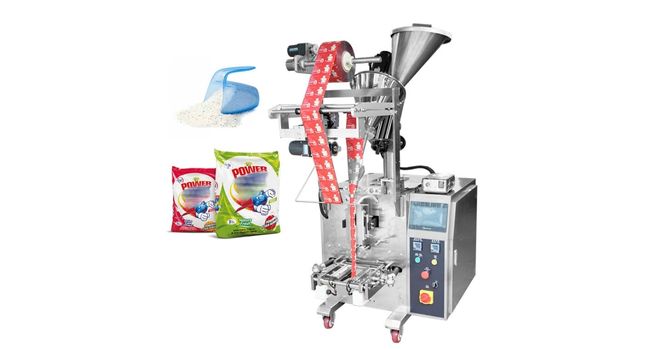
Wwashing detergent powder filling and sealing machine
Drive Mechanism
This mechanism is composed of the motor system and power system together with various other parts.
They all work in sync to drive the various moving parts of the Powder Packing Machine.
Control System
The mechanical components in a Powder Packing Machine are coordinated together through a Programmable Logic Controller (PLC).
Most machines have PLC integrated with a human-machine interface (HMI). Normally, this ensures easy operation, control, and configuration of the entire process.
Loading System
It is where you will load packages you wish to fill with powder.
This system may also contain gripping arms and feeding rollers to ensure the stability of the packages while being processed.
Dosing System
This system supplies and fills the powder product into the packages.
The powder product used in the filling process is dispensed using a component of the dosing system called an auger fill.
Conveyor System
Fully automatic Powder Packing Machines mostly apply conveyor belts that move intermittently to transfer the empty and filled packages.
The semi-automatic ones may not have fully intermittent conveyor belts due to the manual input of packages.
Dusting System
Some modern conveyor belts have a dusting system incorporated into the machine design.
They are responsible for controlling the particulate dust emitted. Some key components include dust collectors, dust nozzles, and hoods.
Discharge System
The fully packaged powder leaves the machine through this section.
It may be customized depending on the next processing stage of the packed powder product.
16. Working Principle Of Powder Packing Machine
The operation principle of a Powder Packing Machine is always similar in many machines, but variation occurs in the type of packaging used.
The major powder-filling processes are bottle powder packing, pouch powder packing, and sachet powder packing, each with its principle.
Bottle Powder Packing Machine
The premade bottles are placed upright and in a single file at the infeed system.
Bottle grippers then clench the bottles and take them to the next station, where the powder will be filled inside them.
A jet of clean air is blasted into the bottles using a blower to remove any unwanted impurities or air.
The auger filler dispenses the precise amount of powder product into the container and is capped and sealed.
The bottles can be labeled before or after filling them and then discharged into a conveyor for further processing.
It may include printing the manufacturer details on the bottle and the expiry dates using inkjet printers.
Pouch Powder Packing Machine
The premade pouches are loaded into the in-feed system directly and singled out to ensure precise picking by the machine.
If the machine is fully automated, the pouches will be grabbed by a vacuum suction arm and transferred to the grippers.
The pouch is grasped by the pouch grippers on both top sides and taken to the opening jaws where they are opened.
To ensure they are fully open, fresh air is blasted into them using a jet blast blower.
The precise powder product is dispensed using the auger filler into the pouches, with excess powder dust collected on a dust hood on top of the filler.
The excess air in the pouches is then expelled by smoothly squeezing the pouches using the deflator plates and sealed using hot seal bars.
Sachet Powder Packing Machine
The operating principle of packing powder products in sachets is the same as powder packing in pouches.
As the name suggests, one machine uses pouches while the other handles sachets.
17. Integrating A Powder Packing Machine With Other Packing Machines
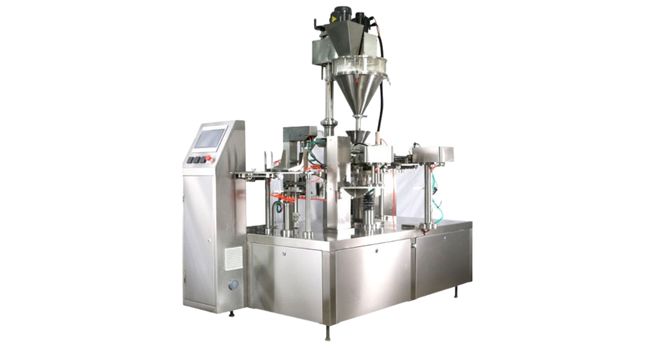
Automatic powder packing machine
The Powder Packing Machine can be stand-alone or integrated into the process line with other packing machines.
An example is integrating the powder-packing machine with the powder-processing machine just before the powder filling begins, like a ribbon mixer.
The Ribbon mixer will process the powder and deposit it in the container, which the auger filler will use to fill the packages.
The Powder Packing Machine can also be integrated with a Carton Forming and Packing Machine.
It means that after the pouches are formed, filled, and sealed, they are conveyed to the carton packing machine as finished products.
They will then be packed into boxes and sealed, making all these processes seamless.
Conclusion
In summary, many powder-packing machines are available in the market today. I hope this information makes choosing the best powder filling and packing machines easier.
For any questions or inquiries on powder packing machines, contact us now.
Related Resources:


